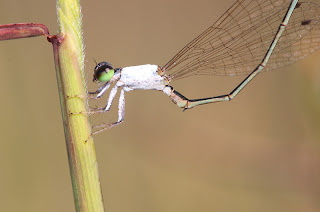No: 106 / Family: Coenagrionidae / Genus: Agriocnemis
Name: Agriocnemis f. femina / Variable Wisp / แมลงปอเข็มเล็กขนขาว
Habitat: Small to medium sized ponds and lakes, surrounded by grasses
Province(s): Widespread
In flight: Year-round / Sightings (by me): Very common
In flight: Year-round / Sightings (by me): Very common
Easily confused with: Agriocnemis minima, Agriocnemis pygmaea
Another microscopic species that belongs to the Agriocnemis genus, is Agriocnemis femina femina. I have overlooked this species for long periods of time, basically because I used to think that a pruinosed Agriocnemis pygmaea was in fact this species (yes, I had a lot to learn back then!) I then learned that this species wasn't actually even present in Khon Kaen and the surrounding areas. Well, in over a year of searching I have only come across A. pygmaea (No. 18 on my blog) and A. minima (No. 17 on my blog). I eventually saw a male in Chiang Mai, but didn't really take much notice of it. It was only when I visited Khao Soi Dao NP that I noticed a small ditch early in the morning just outside the entrance. I had a quick look and noticed Agriocnemis was present. I managed to get a good photo of a pruinosed male and YES! it was A. femina (I have to take a photo to tell the species apart as they are so small). That was the only Agriocnemis species present at that ditch. Since then, I have seen this species at many locations.
The 'mature' male
At certain times of the year (seems to be late in the year), there are hundreds of these little fellows seemingly floating around like little bits of fluff. I think they look great close up. Can be identified by its anal appendages.
Agriocnemis femina, close up - cleaning his appendages (explained to me by Noppadon Makbun)
Agriocnemis femina, close up - now showing a strange appendage near his genitalia
A semi-mature male
Still has slightly red end segments, but is only half pruinosed
The young male
The young male is the most common of all and is almost identical to Agriocnemis pygmaea, except for the caudal appendages. It is also possible to identify as A. femina as S7 has more of a physical change from black to orange, whereas S7 on A. pygmaea is more of a gradual change from black to orange.
Caudal appendages
Agriocnemis femina, male (caudal appendages) - the easy way to differentiate this species. Looks a bit like a character from the Muppets, I think.
The 'old' female
This very old female I can only correctly identify, as it was the only Agriocnemis species present at a small ditch in Chantaburi. It's the easy way to tell! If both species were present, I'm not sure I could tell the difference at this stage.
The sub-adult female
The young female can be identified by having prominent black marks on the pronotum (neck).
The 'green' female
The copula
Here's a young male with a very young female.
Not the best angle in the world, as they sat really low down in a ditch and I couldn't get anywhere near low enough. This is an old male with a very young female... this would be deemed illegal in the human world!




%2B-%2B1182.jpg)
+0196.jpg)


%2B-%2B1240.jpg)

+-+0318.jpg)


No comments:
Post a Comment